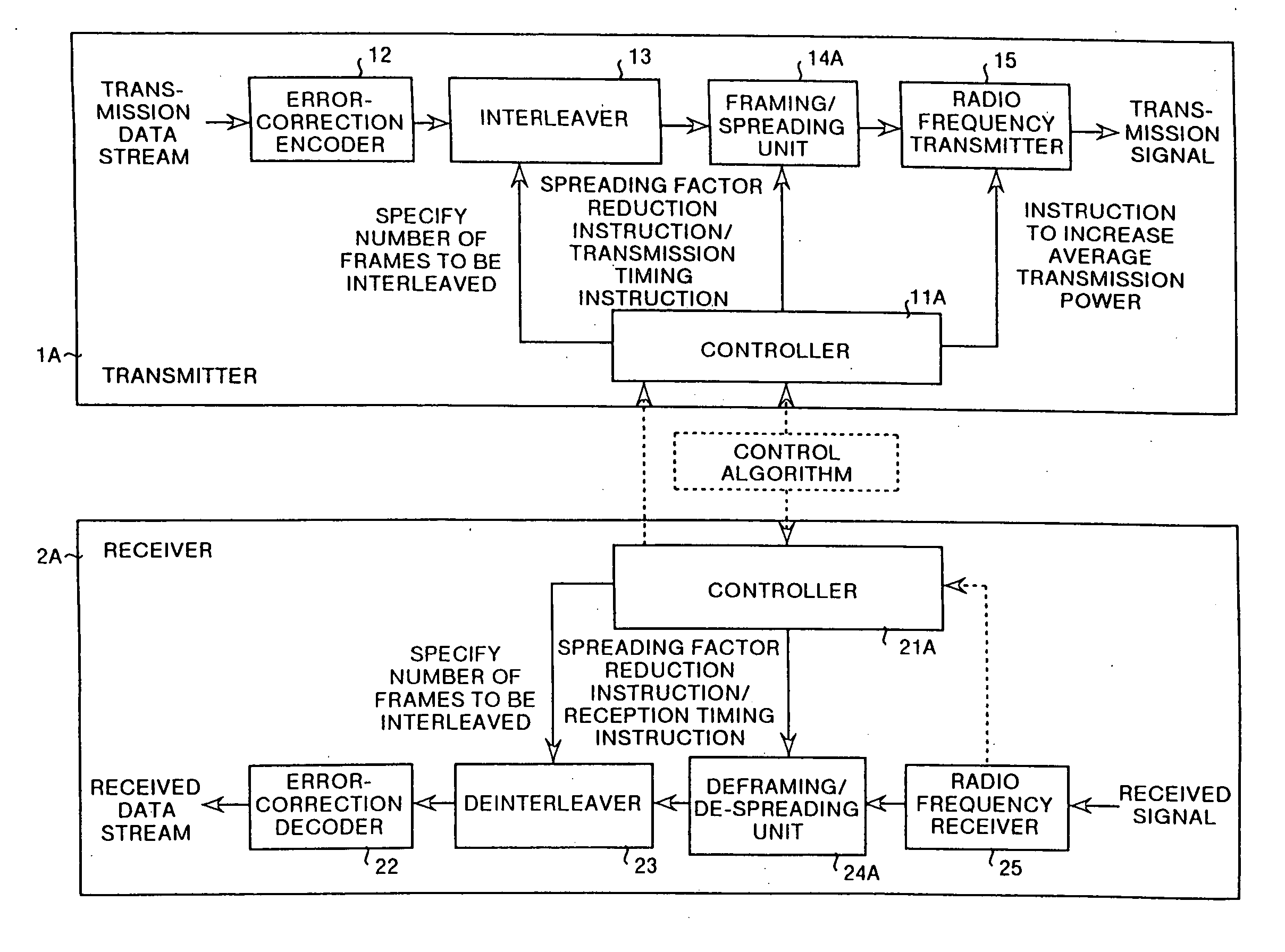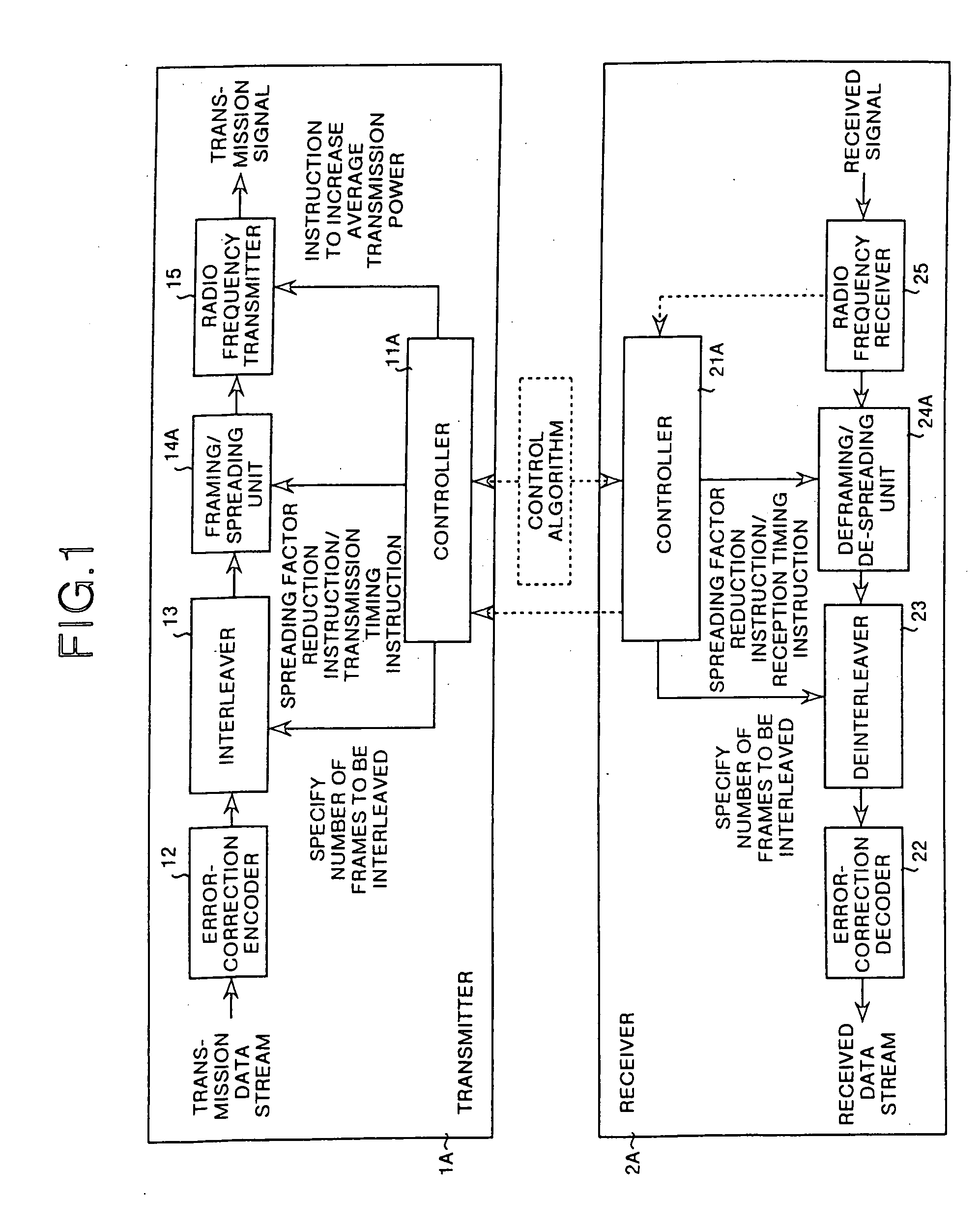Spread spectrum communication device and spread spectrum communication method
a technology of communication device and spread spectrum, which is applied in the field of communication device, can solve the problems of poor decoding at the reception side, complicated constitution, and increase the size of the constitution of the receiver, so as to achieve the effect of facilitating the handover between different systems
- Summary
- Abstract
- Description
- Claims
- Application Information
AI Technical Summary
Benefits of technology
Problems solved by technology
Method used
Image
Examples
first embodiment
[0146] To begin with, the constitution of a CDMA system will be explained. FIG. 1 is a block diagram showing a CDMA system according to the present invention. The CDMA system comprises a transmitter 1A and a receiver 2A. Such a CDMA system is provided with both base station and mobile stations. The base station and the mobile stations carry out radio communication using a CDMA communication method.
[0147] The transmitter 1A, as shown in FIG. 1, comprises a controller 11A, an error-correction encoder 12, an interleaver 13, a framing / spreading unit 14A, a radio frequency transmitter 15, etc. Through negotiations with the receiver 2A, the controller 11A principally controls the operations of the interleaver 13, the framing / spreading unit 14A, and the radio frequency transmitter 15. Through negotiations with the receiver 2A, this controller 11A instructs, using frame numbers, objects for interleaving appropriate for a normal mode (a non-compressed mode) and compressed mode. Furthermore, ...
second embodiment
[0169] Next, frame transmission including the compressed mode will be explained. FIG. 9 is a diagram explaining frame transmission of a downlink according to the In FIG. 9, the vertical axis represents transmission rate / transmission power, and the horizontal axis represents time. In the CDMA system, during normal transmission, a period of time is provided to slot the frame and transmit it intermittently, and the strength of the other frequency carriers is measured using the fact that frames are not transmitted during that period. For this purpose, the slotted frame must be compressed, but if interleaving is performed in the same manner as in normal transmission, the interleaving time will be insufficient, and it will be impossible to obtain an adequate interleaving effect.
[0170] Accordingly, the transmission timing of the compressed frame is divided, and one part is allocated to the head of the frame, the other is allocated to the end of the same frame, securing the desired interle...
third embodiment
[0177] Firstly, frame transmission including compressed mode will be explained. FIG. 12 is a diagram explaining frame transmission of a downlink according to the In FIG. 12, the vertical axis represents transmission rate / transmission power, and the horizontal axis represents time. In the CDMA system, during normal transmission, a period of time is provided to slot the frame and transmit intermittently, and the strength of other frequency carriers is measured using the fact that frames are not transmitted during that period. For this purpose, the slotted frame must be compressed, but if interleaving is performed in the same manner as in normal transmission, there will only be half the necessary interleaving time, making it impossible to achieve adequate interleaving effects.
[0178] Accordingly, the transmission duration of the compressed frame is divided in correspondence with multiple slots, and the non-transmission period (idle period for measuring) is reduced so as not to affect t...
PUM
 Login to View More
Login to View More Abstract
Description
Claims
Application Information
 Login to View More
Login to View More - R&D
- Intellectual Property
- Life Sciences
- Materials
- Tech Scout
- Unparalleled Data Quality
- Higher Quality Content
- 60% Fewer Hallucinations
Browse by: Latest US Patents, China's latest patents, Technical Efficacy Thesaurus, Application Domain, Technology Topic, Popular Technical Reports.
© 2025 PatSnap. All rights reserved.Legal|Privacy policy|Modern Slavery Act Transparency Statement|Sitemap|About US| Contact US: help@patsnap.com



